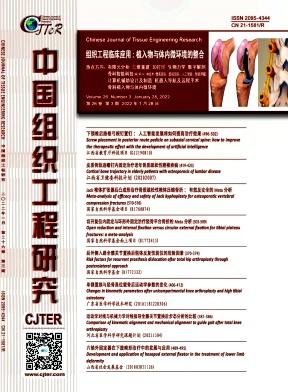Consistency and repeatability of CT and MRI in measurement of spinal canal area in patients with lumbar spinal stenosis
Q4 Medicine
引用次数: 0
Abstract
BACKGROUND: The domestic and overseas scholars have conducted a large number of studies on the measurement of spinal canal area in patients with lumbar spinal stenosis by CT and MRI. However, due to differences of individuals, spinal canal morphologys, measurement methods and measurement planes, there is no recognized measurement standard and value for the measurement of lumbar spinal canal area at present. There are few reports to evaluate the consistency and repeatability of CT and MRI in measuring lumbar spinal canal area. OBJECTIVE: To analyze the consistency and repeatability of three-dimensional reconstruction CT and MRI in measuring the cross-sectional area of lumbar spinal stenosis, and to explore the best imaging measurement method for the cross-sectional area of lumbar spinal stenosis. METHODS: The preoperative imaging data of 102 patients with lumbar spinal stenosis who underwent surgical treatment in Department of Spinal surgery, the Affiliated Hospital of Southwest Medical University from January 2013 to January 2018 with three-dimensional reconstruction CT and lumbar MRI were collected. The corresponding spinal canal area of each narrow intervertebral disc on three-dimensional reconstruction CT and lumbar MRI images was measured by two spinal surgeons at three different time points. The spinal canal area corresponding to the midline plane of the narrow intervertebral disc parallel to the lower endplate of the upper vertebral body was selected for measurement. Paired t-test was used to analyze the difference in spinal canal area between the results of the two methods. Pearson correlation analysis was used to evaluate the correlation between the results of spinal canal area between the two methods. Intraclass correlation coefficient and Bland-Altman plot were used to analyze the consistency and repeatability of the two methods in measuring the area of narrow lumbar spinal canal. Z-test was used to compare the ICC values of interobserver and intraobserver in measurement of narrow lumbar spinal canal area by the two methods. The protocols were approved by the Affiliated Hospital of Southwest Medical University Ethics Committee (approval No. KY2020176). RESULTS AND CONCLUSION: (1) The values of narrow lumbar spinal canal measured by three-dimensional reconstruction CT and MRI were (136.28±2.38) mm and (139.98±2.30) mm; there were significant differences between them (t=-3.96, P < 0.001). Pearson correlation analysis showed that there was a positive correlation between three-dimensional reconstruction CT and MRI measurement of narrow lumbar spinal canal area (r=0.950, P < 0.001). (2) The values of interobserver ICC and intraobserver ICC were 0.908-0.937 and 0.942-0.971. The values of interobserver ICC and intraobserver ICC measured by lumbar MRI were higher than those measured by three-dimensional reconstruction CT (P < 0.05). (3) Bland-Altman plot showed that the 95% distribution range of the difference of spinal canal area between the two methods was -8.0-5.5 mm. Six points were outside the range, accounting for 3.66%. (4) The results showed that there was a significant difference in spinal canal area between three-dimensional reconstruction CT and MRI, but there was a strong positive correlation. The consistency and reproducibility of measurement of narrow lumber spinal canal area by two imaging examinations were good, but the consistency and repeatability of lumbar MRI in measuring narrow lumber spinal canal area were better than that of three-dimensional reconstruction CT.腰椎管狭窄症CT与MRI测量椎管面积的一致性与重复性
背景:国内外学者对腰椎管狭窄症患者椎管面积的CT和MRI测量进行了大量研究。然而,由于个体、椎管形态、测量方法和测量平面的差异,目前对腰椎管面积的测量还没有公认的测量标准和价值。很少有报道评估CT和MRI测量腰椎管面积的一致性和可重复性。目的:分析三维重建CT和MRI测量腰椎管狭窄症截面积的一致性和重复性,探讨最佳的腰椎管狭狭窄截面积成像测量方法。方法:收集2013年1月至2018年1月在西南医科大学附属医院脊柱外科接受手术治疗的102例腰椎管狭窄症患者的三维重建CT和腰椎MRI的术前影像学资料。两名脊柱外科医生在三个不同的时间点测量了三维重建CT和腰椎MRI图像上每个狭窄椎间盘的相应椎管面积。选择与平行于上椎体下端板的狭窄椎间盘中线平面相对应的椎管面积进行测量。采用配对t检验分析两种方法的椎管面积差异。采用Pearson相关分析法评价两种方法椎管面积测量结果之间的相关性。采用组内相关系数和Bland-Altman图分析两种方法测量狭窄腰椎管面积的一致性和重复性。Z检验用于比较两种方法测量狭窄腰椎管面积时观察者间和观察者内的ICC值。该方案经西南医科大学附属医院伦理委员会批准(批准号:KY2020176)。结果与结论:(1)三维重建CT和MRI测量的狭窄腰椎管的值分别为(136.28±2.38)mm和(139.98±2.30)mm;Pearson相关分析表明,三维重建CT与MRI测量腰椎管狭窄面积呈正相关(r=0.950,P<0.001)。(2)观察者间ICC值和观察者内ICC值分别为0.908-0.937和0.942-0.971。腰椎MRI测量的观察者间ICC和观察者内ICC值均高于三维重建CT测量的值(P<0.05)。(3)Bland-Altman图显示,两种方法椎管面积差异的95%分布范围为-8.0-5.5mm,占3.66%。(4)结果显示,三维重建CT与MRI在椎管面积上有显著差异,但有很强的正相关性。两种影像学检查测量椎管狭窄面积的一致性和重复性较好,但腰椎MRI测量椎管狭窄区域的一致性及重复性优于三维重建CT。
本文章由计算机程序翻译,如有差异,请以英文原文为准。
求助全文
约1分钟内获得全文
求助全文
来源期刊

中国组织工程研究
Medicine-Orthopedics and Sports Medicine
CiteScore
0.30
自引率
0.00%
发文量
61083
期刊介绍:
Chinese Journal of Tissue Engineering Research (CJTER) is supervised by the Ministry of Health, and sponsored by the Chinese Association of Rehabilitation Medicine and the Editorial Board of CJTER.
CJTER is publishing the latest progress in tissue engineering research.Our main sections include stem cells, tissue constructions, biomaterials, orthopedic implants,digital orthopedics,organ tissue and cell transplantation.
Efficiency of publication: All manuscripts accepted will be reviewed within 1 month.Time from acceptance to publishing is 3 months for excellent manuscripts, and 6 months for normal manuscripts.
 求助内容:
求助内容: 应助结果提醒方式:
应助结果提醒方式:


